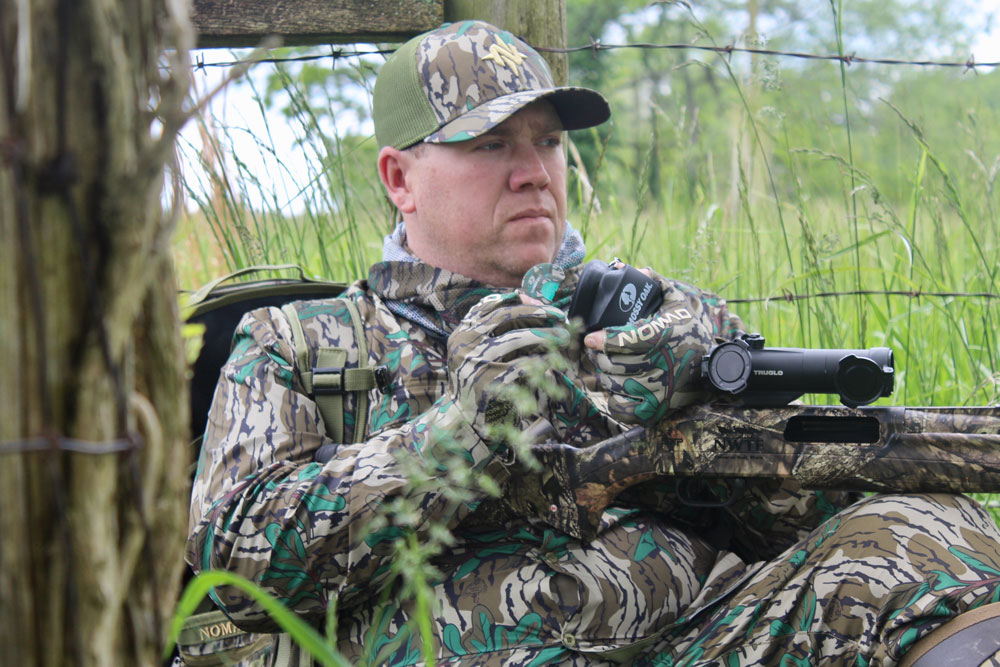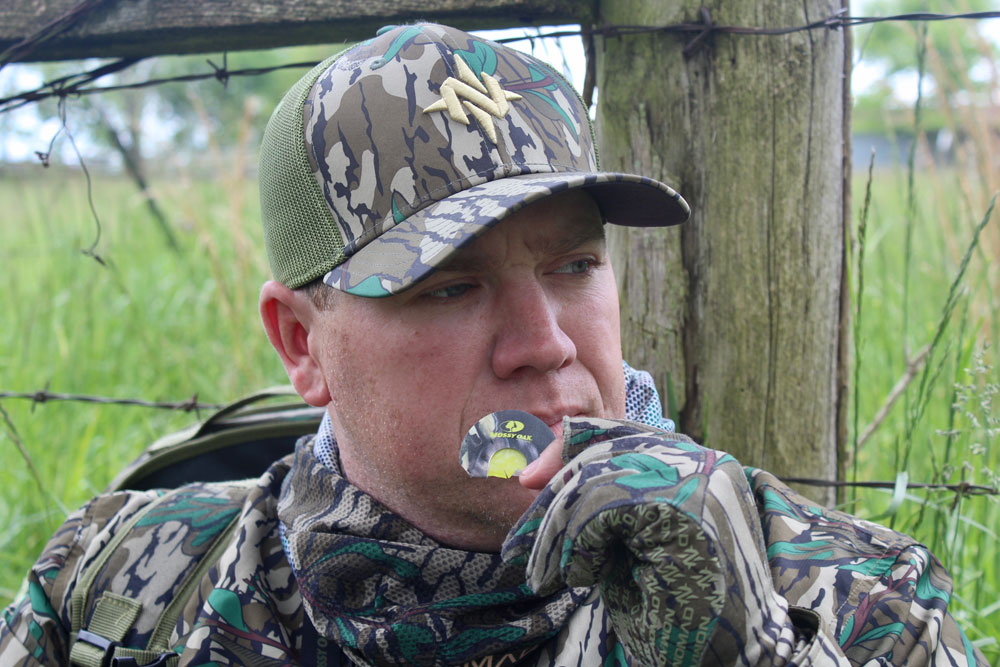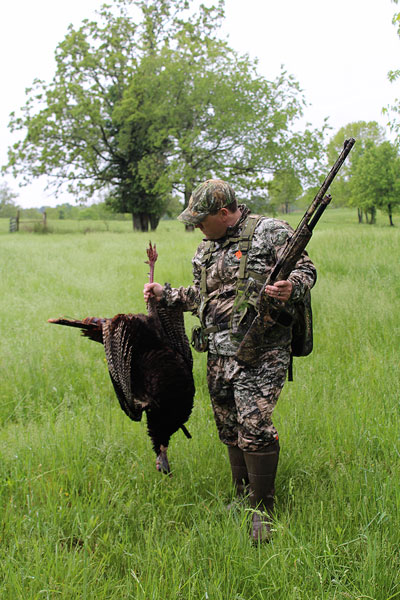Heath Wood

Even though it was my buddy's wedding day, we were in a personal battle with two gobblers that we had been hunting the previous four days.
Each day we would walk in quietly, get close to them on the roost and wait for them to fly down. The first day we got close, however, after making a solid attempt to call out the hens that they had already claimed keeps on, we decided to come back the next morning to try it again.
On the second day, we again got close on the roost; only this time, as soon as we made a few calls, they headed in the opposite direction. Being in the latter part of the season, we figured that the two mature toms had probably become somewhat call shy.
On the third day, we decided we were going to play the stealth game - that of slipping in quietly and staying quiet with our calling for as long as possible. In hopes of keeping our presence unknown, the gobblers would not go in the opposite direction. In textbook fashion, the two gobblers flew down from the roost and immediately let out a ground-shaking gobble. The two toms were a mere 50 yards from us on the other side of a small hill. Since we were set up in the timber, we could hear the toms strutting around in the leaves as they inched closer and closer to our setup. After 20 minutes of being on the ground, we still had not made a call, trying to stay patient until the last minute.
When the two toms had finally made their way past our location, we knew that we were going to have to make a call or they were going to pass us. With a slate call, I made 3 to 4 soft yelps, trying to stay low key. After a couple of minutes, one of the toms let out a gobble. With disbelief, the two toms were already 75 to 100 yards away in the opposite direction. For the third day in a row, we had been schooled by two of the most call shy turkeys I have ever encountered.
The fourth day of trying to wrangle the shy turkeys also happened to be my buddy's wedding day. At 1:00 that afternoon, he would be standing at the altar with his bride, expressing their love. However, as the day began, we were back in the woods trying to figure out how to express our love to these two gobblers that they seemed to get cold feet every time they heard us.
As we walked through the dark, leading up to where the two birds had been roosted all week, we could hear that they were roosted on the same side of the hill that they had been the three previous days. Instead of getting close and making a call, my buddy decided that he would make a circle, plenty of distance out of the way, and get on the side that they had been traveling when we finally made a call.
"If you make a call, they will head my direction, and I'll be ready for the shot," said my hunting partner.

As with the previous days before, I eased as close as I could on the opposite side of the hill from where they were roosted to see if I could coax them over the hill, into gun range. Like the previous day, I stayed quiet for as long as I could. Finally, I could hear one of the toms drumming over the hill from me. I heard what sounded like a few hens scratching in the leaves in front of them. I decided I needed to make a call to break them away and come those last few yards into gun range. In my head, I was close enough that they would not go the other way when I made a call. I made a soft yelp, followed by two soft purrs on my diaphragm call, this sadly was followed by no response.
After 2-3 minutes of silence, boom! On the next ridge over, my buddy had just shot his wedding day gobbler. The two toms hurried over the hill as soon as they heard my call. Our strategy worked.
During the latter part of the season, turkeys, specifically toms, have heard every kind of call, been spooked, shot at, and everything in-between as hunters try their best to make the harvest. During this time, birds become call shy as with my buddy and my encounter. Anytime they hear a call, they either go the other way or simply shut up and do not say a word as they ease away. When it is late in the season, I have become accustomed to a couple of different strategies that create enough curiosity and desire for a gobbler to come to check me out, even when they do not feel comfortable.
The first thing to do, as we did during the mentioned hunt, use woodsmanship to play a sort of chess game in guessing tom’s next move. To obtain this knowledge and skill, one must spend time before the hunt, scouting an area out, and knowing where all obstacles are located that might cause a tom to hang up or go the other way, including fences, bodies of water, etc. The next tactic is spending time in the field and knowing where a turkey's most favorable travel routes are. If turkeys are not responding to a hunter's calls, simply go where they are most likely to go on their own, stay quiet, and be patient.
By experiencing what the two toms’ travel route was after we made the mistake of calling for multiple days in a row, we were able to make the right setup and still make the harvest without calling them in. When birds become tough to hunt during the late season, hunters must adjust to doing whatever it takes to make the harvest.
Another strategy that I use is a season-long task that I try to perform, which prevents gobblers from ever becoming call shy in the first place. On public land, it is easy for gobblers to hear several different hunters' version of a hen trying to sweet talk a tom. After several close encounters, toms tend to become wary of a call, also known as call shy. When hunting private land, I feel like it is easy to use the same favorite call, morning after morning, or the same sequence of calls, and I feel as though turkeys become aware of the same sounds.
 To prevent a tom from ever becoming aware of the same sounds or the pressure of hunting, I try to become versatile, yet conservative with my calls. For example, on private land especially, I save 2 or 3 mouth calls and maybe a box call until that last part of the season—these calls I have not used prior, making them something that the gobblers have not heard. Not only am I changing calls, but I also try to call in a sequence that I have not used during that season as well. Lately, I have been wearing my Colosseum Outdoors, Mossy Oak Call Caddy, that allows me to keep a variety of different styles of diaphragm calls within reach at all times. I am continually changing mouth calls to keep sounding like a different hen each time I set up on a gobbler.
To prevent a tom from ever becoming aware of the same sounds or the pressure of hunting, I try to become versatile, yet conservative with my calls. For example, on private land especially, I save 2 or 3 mouth calls and maybe a box call until that last part of the season—these calls I have not used prior, making them something that the gobblers have not heard. Not only am I changing calls, but I also try to call in a sequence that I have not used during that season as well. Lately, I have been wearing my Colosseum Outdoors, Mossy Oak Call Caddy, that allows me to keep a variety of different styles of diaphragm calls within reach at all times. I am continually changing mouth calls to keep sounding like a different hen each time I set up on a gobbler.
I wear a turkey vest like the Nomad MG turkey vest that has different compartments built-in for a box call, multiple slate and glass calls as well other pockets to hold a wide variety of varying turkey calls. A turkey vest is like a fisherman's tackle box, do not be afraid to change it up along the way and keep them guessing until they hear the one that they can't resist.
As for public land hunting, I like to keep a couple of different calls stored away in my vest for the late season. These calls are usually calls that I feel like not a lot of hunters use as much—for example, the Primos Foggy Bottom Snuff Tube call. A tube call is a call that not very many hunters feel comfortable using. It takes practice to apply; however, when you do, it has a tremendous realistic sound, yet it has not been heard as much by gobblers.
Some hunters will disagree with the theory that gobblers recognize sounds that hunters make. In my own experience, I have hunted public land birds that I swear could tell you the brand name and type of call that was being used because they have been pressured that much. The next time you encounter these types of call-shy, hard-to-hunt toms. Remember to be diverse in your calling and keep them guessing, as well as always knowing when and where a tom wants to go naturally. By doing so, you will be using the hashtag #taggedout year after year.



























